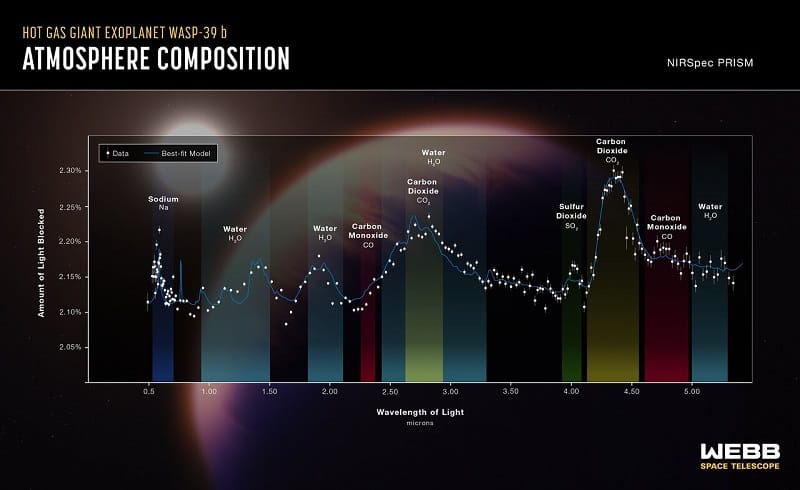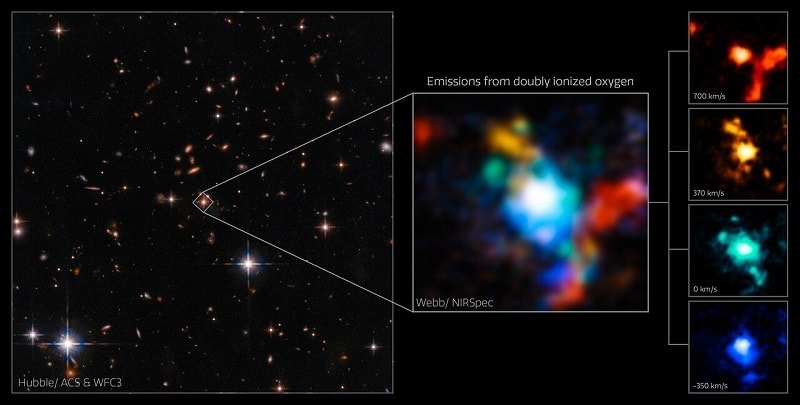A year after its launch, astronomers are revealing the secrets of the universe, as the first scientific results from observations made by the James Webb Space Telescope (JWST) are released. To learn more about the momentous discoveries, Physics World is publishing a series of blog posts on the discoveries. This post is the third post in the series – you can read the previous one here.

It was an active final day at the First Science Results from JWST conference at the Space Telescope Science Institute in Baltimore, US, where discussion turned to some incredible observations of quasars above redshift 6, showing them as they existed more than 12.7 billion years ago.
As the compact cores of galaxies with extremely active supermassive black holes, we know that quasars can shine many times brighter than their host galaxy. In his presentation, John Silverman of the University of Tokyo described how data from the JWST’s CEERS (Cosmic Evolution Early Release Science) survey is following up on a dozen high-redshift quasars originally identified by the Subaru Telescope on Mauna Kea.
Throughout the conference, astronomers have joked that high redshift no longer means what it used to mean. Before JWST came along, high redshift for the Hubble Space Telescope meant resolving the host galaxies of quasars out to about redshift 2, or roughly 10 billion years in the past. Now, JWST is resolving the structures of host galaxies around quasars at redshift 6 (almost 12.7 billion years ago).
Much happened in the Universe between redshifts 2 and 6, and astronomers are keen to see if the ratio of the mass of a supermassive black hole at the centre of a galaxy relative to the mass of its host galaxy (or more specifically the stellar mass of the galaxy’s bulge) still holds at the highest redshifts. The answer will tell us about the conditions under which supermassive black holes and galaxies formed, and how they affected each other’s growth.
The mass ratio between a supermassive black hole and the bulge of a galaxy around it is 1:200, with this value believed to be connected to feedback from the black hole in the form of outflows of radiation spewing out as it accretes matter. The relation was first quantified by observations with the Hubble Space Telescope in the 1990s, with Silverman calling it “fundamental.”
It turns out that high redshift galaxies do indeed also stick to this relation. Silverman said that astronomers have targeted redshift 6 because it’s at this redshift that simulations of galaxies tend to differ the most. What astronomers really need is some hard and fast data to input into the simulations, and JWST has been happy to oblige.
The typical galaxy hosting a quasar at this redshift is just 8% as luminous as the quasar. However, it’s actually possible to take the glare of a quasar out of the image – since the quasar itself appears point-like, it manifests as diffraction spikes that can be removed by a point spread function.
JWST finds the galaxies to be fairly compact and disc-shaped, with surprisingly well-defined spiral arms and central bars just a billion years after the Big Bang. In her talk, Madeline Marshall, of NRC Herzberg in Victoria, Canada, discussed the first high-redshift quasar results from JWST’s Near-Infrared Spectrometer (NIRSpec), finding their black holes to weigh billions of solar masses, and the mass of their host galaxies to be in the region of hundreds of billions, therefore seeming to maintain the mass ratio observed at lower redshift.
How exactly black holes grew to be so massive so early in the Universe is still under debate, but hopefully JWST will start to provide some answers. Just to give an indication of the telescope’s power, JWST’s resolution is so fine that some of the quasar images show companion galaxies merging or interacting with the main galaxy, sporting tidal tails and bursts of star-formation at a rate of 30–50 solar masses per year.
Exoplanets and protoplanetary discs
Earlier in the day, exoplanets and protoplanetary discs came under the spotlight. Olivier Berné of the Institut de Recherche en Astrophysique et Planétologie in Toulouse revealed a solution to how planets can form in the ultraviolet-radiation-rich environments of large star clusters.
These star clusters produce their fair share of hot, young, massive stars that emit lots of ultraviolet radiation that ought, in principle, to erode protoplanetary discs around neighbouring lower mass stars. Berné reported how JWST astronomers, working with colleagues from the Atacama Large Millimeter/submillimeter Array, have observed the chemistry of these vulnerable discs and discovered a warm envelope of molecular gas surrounding them.
The envelopes are rich in polycyclic aromatic hydrocarbons, which have a strong infrared spectral signature that stands out to JWST. They also have a high ultraviolet opacity, so they are able to block a lot of the harmful ultraviolet from outside a disc, protecting the early stages of planet formation.
Inside a planet-forming disc
One protoplanetary disc where planet-formation has proceeded quite far is PDS 70. It hit the news in 2018 and 2021 when astronomers using ALMA were able to image rings in PDS 70’s disc that appear to have been carved out by two young planets.
Giulia Perotti of the Max Planck Institute for Astronomy in Heidelberg revealed how JWST can now measure chemistry within the inner region of PDS 70’s protoplanetary disc. It appears to be enriched with small dust grains that have been thermally processed, possibly by outbursts from the young star. The inner disc, meanwhile, is warped, possibly from the influence of another, unseen planet. Chemically, water and oxygen have also been detected in the disc. PDS 70 continues to be our best-studied example of planets forming within a disc of gas and dust.
WASP atmospheres

Meanwhile, Kevin Stevenson of Johns Hopkins Applied Physics Laboratory updated delegates on JWST’s observations of the atmospheres of older exoplanets. First, he recounted the space telescope’s observations of WASP-39b – a “hot Jupiter” 700 light years away.
These observations were made as WASP-39b was transiting its star, with some of the star’s light being absorbed by atoms and molecules in the planet’s atmosphere as it passed through. Using this “transmission spectroscopy”, JWST detected carbon monoxide, potassium, sodium and water in the atmosphere of WASP-39b, as well as sulphur dioxide, which is a product of photochemistry.
It’s the first time photochemical processes, in which radiation from the star alters molecules, have been detected on any exoplanet. The absence of a strong methane line at 3.3 microns is also evidence that photochemistry is transforming methane into other molecular species.
Stevenson then went on to preview results from another hot Jupiter – the planet WASP-43b, which lies 284 light years away. When JWST’s predecessor, the Spitzer Space Telescope, observed WASP-43b it could not detect any thermal emission from the planet’s night-side, which means it must be cold, beyond the limits of Spitzer to detect.
Stevenson revealed that JWST had now detected this faint thermal emission, and – although he couldn’t give details – he described how making this measurement and measuring the temperature of the night-side would allow scientists to better constrain the properties of the tidally locked-planet’s atmosphere.
Tantalising TRAPPIST-1
We also heard new findings from the TRAPPIST-1 planetary system, which consists of seven planets in orbit around a red dwarf star 40 light years away. Björn Benneke of the University of Montreal revealed that JWST had performed reconnaissance of the atmospheres of some of the worlds of TRAPPIST-1.
While he wasn’t able to say anything yet about what JWST had positively detected in their atmospheres, he did reveal that the seventh planet, TRAPPIST-1g, probably does not have a thick atmosphere rich in hydrogen. This would seemingly rule out it being a so-called ‘Hycean’ world, consisting of an ocean kept warm by a thick swathe of hydrogen. Since planet ‘g’ is at the very outer edge of TRAPPIST-1’s habitable zone, it might mean that without a thick insulating atmosphere, TRAPPIST-1g could be too cold to be habitable to life as we know it.
The three-day conference was an exciting preview of how JWST is beginning to transform astronomical research and allow us to detect things that were completely beyond astronomers until now. Sometimes the conference presentations were frustratingly light on details – many said they’d have more to say next year, particularly at the 241st meeting of the American Astronomical Society (AAS) on 8–12 January in Seattle.
We have to remember, though, that JWST has only been collecting data for barely six months. Given the complexity of both the telescope and the information it is collecting, astronomers are making sure to take care with their findings. If the preliminary results from this first JWST science conference are any indication, then the next few years could be some of the most exciting times ever for astrophysicists, cosmologists and planetary scientists.
